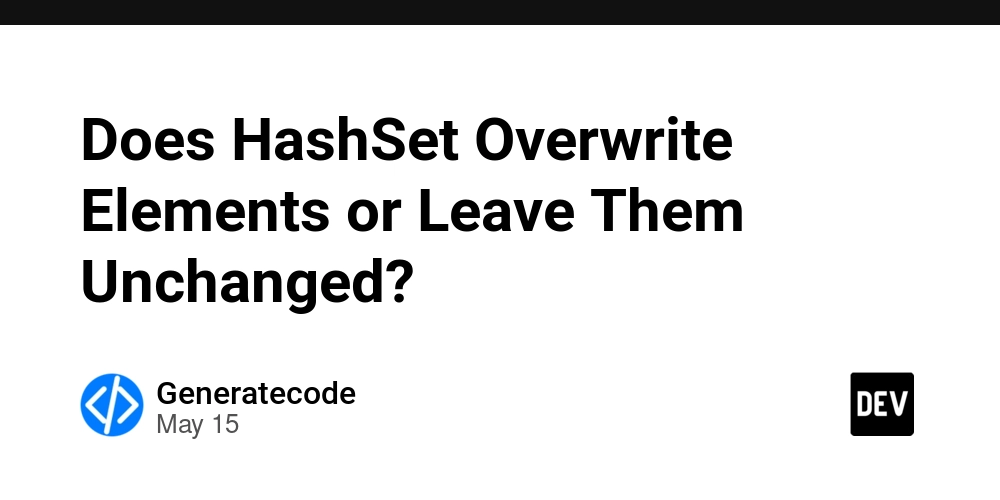Does HashSet Overwrite Elements or Leave Them Unchanged?
When working with Java's HashSet, many developers often find themselves in a conundrum when it comes to understanding how the collection handles duplicate elements. Specifically, there appears to be a contradiction between some explanations regarding the behavior of the add() method. Let's clarify the underlying mechanics of HashSet and answer this pressing question: "Does HashSet overwrite duplicate elements or leave the set unchanged?" Understanding HashSet Behavior The HashSet class in Java is a part of the Java Collections Framework. It is designed to store unique elements, which means it does not allow duplicate entries. The crux of the confusion often stems from how HashSet handles an attempt to add a duplicate element. Let's break down the theories and examine the documentation. The Properties of HashSet According to the properties of HashSet, as mentioned in various educational resources: Property 1: A HashSet does not allow duplicate elements. Property 2: If you add a duplicate element, it theoretically appears that an older element could be overwritten. However, this view can be misleading. The key takeaway from this property is that while it may sound like the older element is replaced or overwritten, the reality is far simpler, as confirmed by Java’s official documentation on the add() method. Documentation Confirmation The Java documentation states explicitly that: If this set already contains the element, the call leaves the set unchanged and returns {@code false}. What this means is quite straightforward: when you try to add an element that already exists in a HashSet, the state of the HashSet remains the same, and its size remains unchanged. Therefore, in practical terms, the new insertion does not replace the old element; rather, it just does nothing while returning a false value. Code Examples to Illustrate the Behavior To shed more light on this, let’s take a look at a Java code example demonstrating HashSet behavior with duplicate elements. import java.util.HashSet; public class HashSetExample { public static void main(String[] args) { // Create a HashSet instance HashSet set = new HashSet(); // Adding elements to HashSet set.add("Apple"); // returns true set.add("Banana"); // returns true boolean isAdded = set.add("Apple"); // Attempt to add duplicate // Print the result of adding a duplicate System.out.println("Adding duplicate 'Apple': " + isAdded); // Outputs false System.out.println("Current HashSet: " + set); // Outputs [Apple, Banana] } } Explanation of the Code In the example above, we first create a HashSet and add a couple of elements: "Apple" and "Banana". When we attempt to add "Apple" again, the method add() returns false, indicating that the element was not added since it already exists in the set. The contents of the HashSet remain unchanged, illustrating that the earlier understanding of overwriting is inaccurate. Conclusion To conclude, the HashSet in Java indeed does not overwrite existing elements when a duplicate is added. Instead, the add() method checks if the element is already present and, if so, it maintains the current state of the set while returning false. This characteristic makes HashSet an excellent choice for scenarios where you need to ensure unique elements without modification to the existing entries. If you ever find yourself in doubt about a collection’s behavior, always refer back to the official documentation for the most accurate guidance.

When working with Java's HashSet, many developers often find themselves in a conundrum when it comes to understanding how the collection handles duplicate elements. Specifically, there appears to be a contradiction between some explanations regarding the behavior of the add() method. Let's clarify the underlying mechanics of HashSet and answer this pressing question: "Does HashSet overwrite duplicate elements or leave the set unchanged?"
Understanding HashSet Behavior
The HashSet class in Java is a part of the Java Collections Framework. It is designed to store unique elements, which means it does not allow duplicate entries. The crux of the confusion often stems from how HashSet handles an attempt to add a duplicate element. Let's break down the theories and examine the documentation.
The Properties of HashSet
According to the properties of HashSet, as mentioned in various educational resources:
-
Property 1: A
HashSetdoes not allow duplicate elements. - Property 2: If you add a duplicate element, it theoretically appears that an older element could be overwritten.
However, this view can be misleading. The key takeaway from this property is that while it may sound like the older element is replaced or overwritten, the reality is far simpler, as confirmed by Java’s official documentation on the add() method.
Documentation Confirmation
The Java documentation states explicitly that:
If this set already contains the element, the call leaves the set unchanged and returns {@code false}.
What this means is quite straightforward: when you try to add an element that already exists in a HashSet, the state of the HashSet remains the same, and its size remains unchanged. Therefore, in practical terms, the new insertion does not replace the old element; rather, it just does nothing while returning a false value.
Code Examples to Illustrate the Behavior
To shed more light on this, let’s take a look at a Java code example demonstrating HashSet behavior with duplicate elements.
import java.util.HashSet;
public class HashSetExample {
public static void main(String[] args) {
// Create a HashSet instance
HashSet set = new HashSet<>();
// Adding elements to HashSet
set.add("Apple"); // returns true
set.add("Banana"); // returns true
boolean isAdded = set.add("Apple"); // Attempt to add duplicate
// Print the result of adding a duplicate
System.out.println("Adding duplicate 'Apple': " + isAdded); // Outputs false
System.out.println("Current HashSet: " + set); // Outputs [Apple, Banana]
}
}
Explanation of the Code
In the example above, we first create a HashSet and add a couple of elements: "Apple" and "Banana". When we attempt to add "Apple" again, the method add() returns false, indicating that the element was not added since it already exists in the set. The contents of the HashSet remain unchanged, illustrating that the earlier understanding of overwriting is inaccurate.
Conclusion
To conclude, the HashSet in Java indeed does not overwrite existing elements when a duplicate is added. Instead, the add() method checks if the element is already present and, if so, it maintains the current state of the set while returning false. This characteristic makes HashSet an excellent choice for scenarios where you need to ensure unique elements without modification to the existing entries. If you ever find yourself in doubt about a collection’s behavior, always refer back to the official documentation for the most accurate guidance.












































































































































































![[The AI Show Episode 146]: Rise of “AI-First” Companies, AI Job Disruption, GPT-4o Update Gets Rolled Back, How Big Consulting Firms Use AI, and Meta AI App](https://www.marketingaiinstitute.com/hubfs/ep%20146%20cover.png)
























































































































![[DEALS] The ChatGPT & AI Super Bundle (91% off) & Other Deals Up To 98% Off – Offers End Soon!](https://www.javacodegeeks.com/wp-content/uploads/2012/12/jcg-logo.jpg)



![How to make Developer Friends When You Don't Live in Silicon Valley, with Iraqi Engineer Code;Life [Podcast #172]](https://cdn.hashnode.com/res/hashnode/image/upload/v1747360508340/f07040cd-3eeb-443c-b4fb-370f6a4a14da.png?#)





























































































































![Apple May Not Update AirPods Until 2026, Lighter AirPods Max Coming in 2027 [Kuo]](https://www.iclarified.com/images/news/97350/97350/97350-640.jpg)























































































































![iPhone 17 Air Could Get a Boost From TDK's New Silicon Battery Tech [Report]](https://www.iclarified.com/images/news/97344/97344/97344-640.jpg)
![Vision Pro Owners Say They Regret $3,500 Purchase [WSJ]](https://www.iclarified.com/images/news/97347/97347/97347-640.jpg)





































































